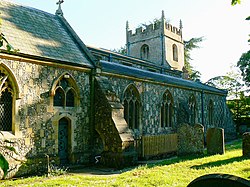Burbage, Wiltshire
| Burbage | |
| Wiltshire | |
|---|---|
 All Saints' church, Burbage | |
| Location | |
| Grid reference: | SU2361 |
| Location: | 51°20’56"N, 1°40’16"W |
| Data | |
| Population: | 1,772 (2011) |
| Post town: | Marlborough |
| Postcode: | SN8 |
| Dialling code: | 01672 |
| Local Government | |
| Council: | Wiltshire |
| Parliamentary constituency: |
Devizes |
| Website: | Burbage Parish Council |
Burbage is a village in the Vale of Pewsey in the north of Wiltshire. It is about six miles south of Marlborough and twenty miles west of Newbury, the latter across the border in Berkshire.
The village High Street was the main north–south road from Marlborough to Andover, now the A346 primary route, until a bypass was built to the west in 1991. A more minor route from Pewsey to Hungerford and the M4 passes to the south of the village.
The parish includes the hamlets of Durley, Eastcourt, Marr Green, Ram Alley, Stibb Green, The Warren (which is close to Tottenham House), and Westcourt.
Burbage stands on a watershed at the eastern end of the Vale of Pewsey, with local streams to the east draining to the Thames, to the north, south and west draining to the Hampshire Avon.
History
The Kennet and Avon Canal, completed in 1810, crosses the parish just north of the village, where it passes through the Bruce Tunnel. Burbage Wharf was further west, where the canal passes under the present-day A346.
The Great Western Railway's Berks and Hants Extension Railway from Hungerford to Devizes was built close to the canal in the 1860s, eventually becoming part of the Reading to Plymouth section of the main line from London Paddington in 1906. The GWR built Savernake Low Level north of the village, above the canal tunnel; British Railways closed it in 1966 but the line remains in use. Until 1947 there was also a goods-only station at Burbage Wharf.[1]
The Midland and South Western Junction Railway opened from Andover to Grafton and Burbage in 1882, the latter station being situated in nearby West Grafton. British Railways closed it in 1961.
The population of Burbage peaked at around 1600 with the building of the railway in 1860, declining to a low point of 1,000 a century later. It has since increased steadily, regaining its 1860s level in the 21st century.[2]
Church and chapel
The Church of England parish church of All Saints was rebuilt in 1854 by T.H. Wyatt, then extended with a south aisle in 1876.[3]
The original church was from the 12th century and was rebuilt in the 14th and 15th, when the tower was added; the porch was added in the 16th. The present church retains only the tower and porch of the earlier building.
The church is now part of the Savernake team ministry.[4]
A small Wesleyan Methodist chapel was built at Eastcourt in 1822, and replaced by a larger building on the High Street in 1906. This closed in 1996 and is now a private house.[5]
Society and sport
Burbage has a village hall.
- Cricket: Burbage and Easton Royal CC[6]
There is one pub: the White Hart, on the High Street in the centre of the village.
Outside links
| ("Wikimedia Commons" has material about Burbage, Wiltshire) |
References
- ↑ Oakley, Mike (2004). Wiltshire Railway Stations. Wimborne: The Dovecote Press. pp. 115–116. ISBN 1904349331.
- ↑ Colin Younger. "A study of the population of Burbage (1801–2001)". www.burbage-wiltshire.co.uk. http://www.burbage-wiltshire.co.uk/historic/population.htm.
- ↑ National Heritage List 1035909: Church of All Saints (Grade II listing)
- ↑ "All Saints Church, Burbage". The Savernake Team. http://www.savernaketeam.org.uk/burbage-and-tidcombe/burbage/.
- ↑ "Wesleyan Methodist Chapels". http://www.burbage-wiltshire.co.uk/historic/chapel.htm#1stChapel.
- ↑ Burbage and Easton Royal CC
- A History of the County of Wiltshire - Volume 16 pp 69–82: Kinwardstone Hundred (Victoria County History)
- Nikolaus Pevsner: The Buildings of England: Wiltshire, 1963; 1975 Penguin Books ISBN 978-0-300-09659-0page 152